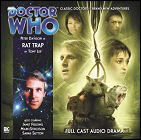 The Doctor and his entourage arrive in 1983 and join an expedition into a network of man-made (but abandoned) subterranean tunnels teeming with rats, but they’re no ordinary rats: these rats show signs of intelligence, and the ability to communicate. Furthermore, they have plans for conquest, including a plan to release a plague capable of wiping out the human race. The Doctor must try to broker some sort of peace with the rats, a task made harder by the presence of Dr. Wallace, the scientist who initially experimented on the rats to augment their intelligence. Unwilling to compromise, the rats intend to destroy humanity and take over the world. Wallace, who was declared dead when his entire research project lost communication with the outside world in the 1960s, feels it’s his duty to deal with the threat, regardless of the cost, even after discovering that one member of the expedition into the tunnels is the daughter he left behind.
The Doctor and his entourage arrive in 1983 and join an expedition into a network of man-made (but abandoned) subterranean tunnels teeming with rats, but they’re no ordinary rats: these rats show signs of intelligence, and the ability to communicate. Furthermore, they have plans for conquest, including a plan to release a plague capable of wiping out the human race. The Doctor must try to broker some sort of peace with the rats, a task made harder by the presence of Dr. Wallace, the scientist who initially experimented on the rats to augment their intelligence. Unwilling to compromise, the rats intend to destroy humanity and take over the world. Wallace, who was declared dead when his entire research project lost communication with the outside world in the 1960s, feels it’s his duty to deal with the threat, regardless of the cost, even after discovering that one member of the expedition into the tunnels is the daughter he left behind.
written by Tony Lee
directed by Ken Bentley
music by Andy HardwickCast: Peter Davison (The Doctor), Janet Fielding (Tegan Jovanka), Mark Strickson (Turlough), Sarah Sutton (Nyssa), John Banks (Clifford Andrews), Alison Thea-Skot (Sally Lucas), Terry Molloy (Dr. Wallace), David Seymour (Kevin), Andrew Dickens (Matthew / Major Harris), Charlie Norfolk (Caitlin Jones)
Timeline: for the Doctor, Tegan and Turlough: between Enlightenment and The King’s Demons; for Nyssa: 50 years after Terminus. This story takes place after Heroes Of Sontar and before Rat Trap.
LogBook entry and TheatEar review by Earl Green
Review: Unconventional to say the very least, Rat Trap is one of those stories that works despite what could be an incredibly silly element at its core (to wit: diabolical talking rats). Everything hinges on the characterization of the rats, and the whole thing flirts with self-parody with the introduction of such characters as the Rat King (it takes real skill to pull this off without being the Nutcracker Suite). As often happens with the  Davison-era crowded TARDIS team, the main characters are separated and left to their own devices to survive as best they can.
Davison-era crowded TARDIS team, the main characters are separated and left to their own devices to survive as best they can.
Propping up a huge part of the story is Terry Molloy, stepping out of Davros’ life support chair to portray Wallace, a character who’s all but dripping with regret and pathos. Molloy always delivers performances of outstanding depth, and Wallace is no exception. He becomes such a well-rounded and real human being that it becomes nearly irrelevant that so much of the story deals with sentient rodentia. Kudos are also due to Mark Strickson, who manages to make Turlough smart and surprisingly ruthless at times – if the character had been written with this degree of cunning from the start, Strickson would’ve had more meat to put on the character’s bones and the Doctor might have been in real danger when Turlough was stalking him at the behest of the Black Guardian.
